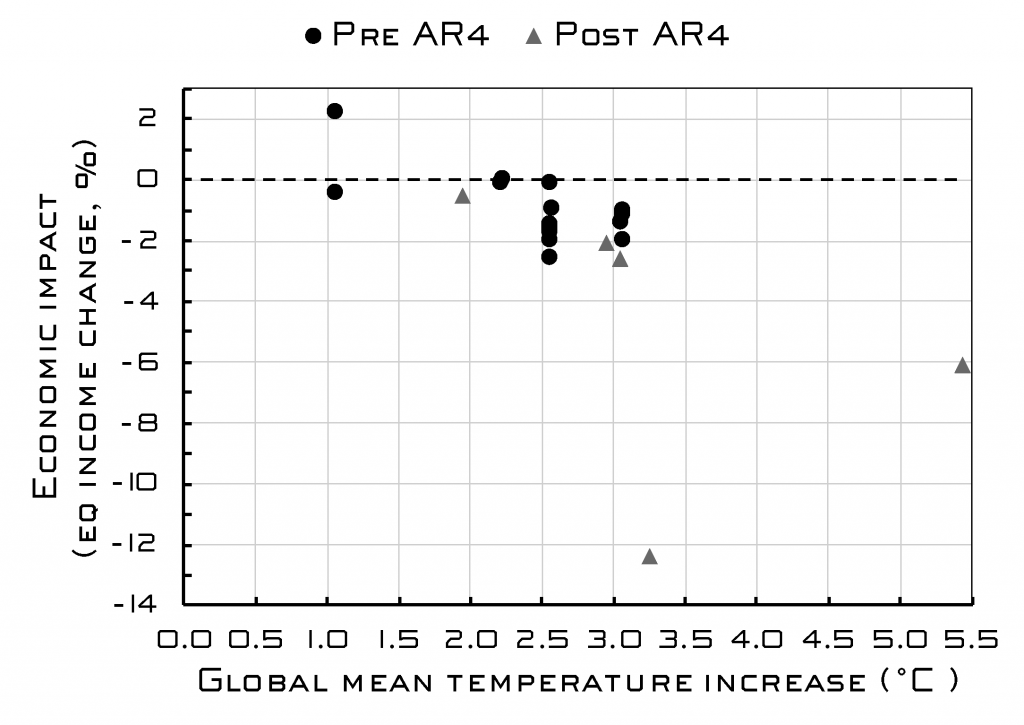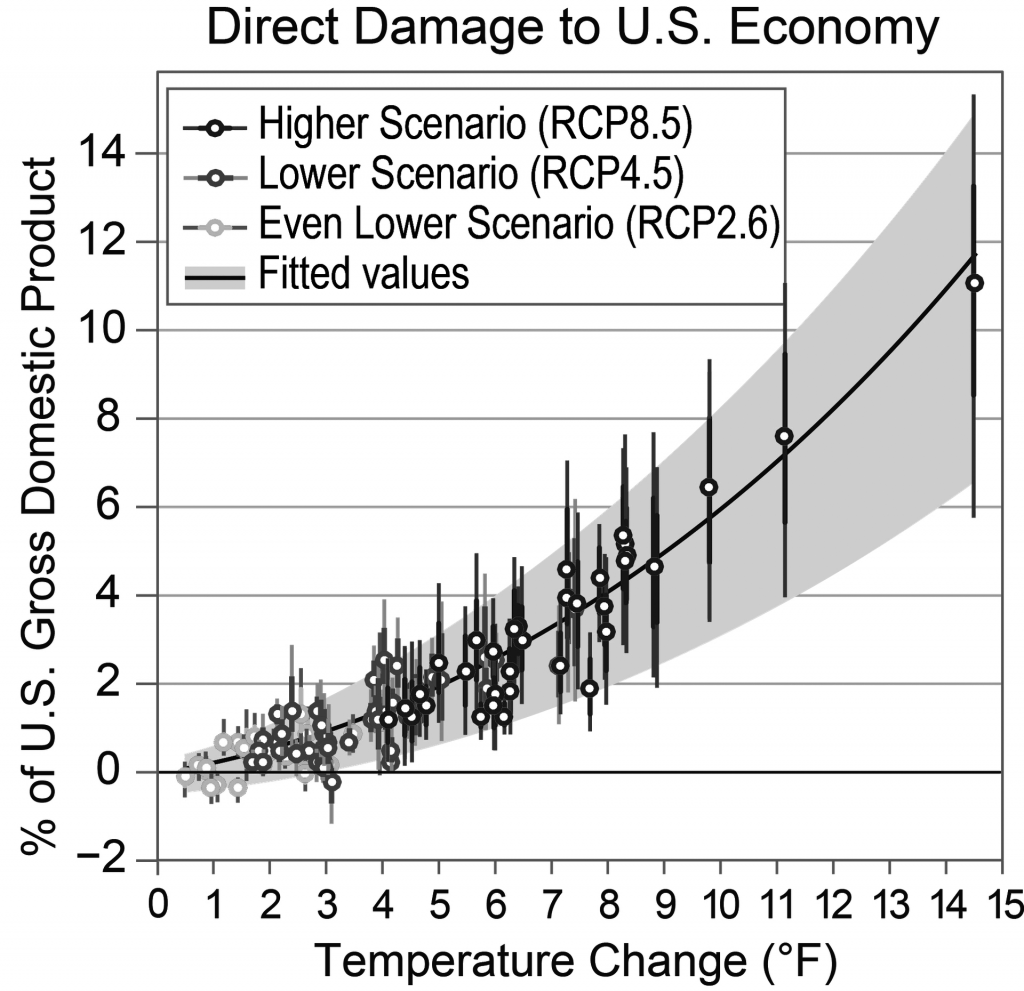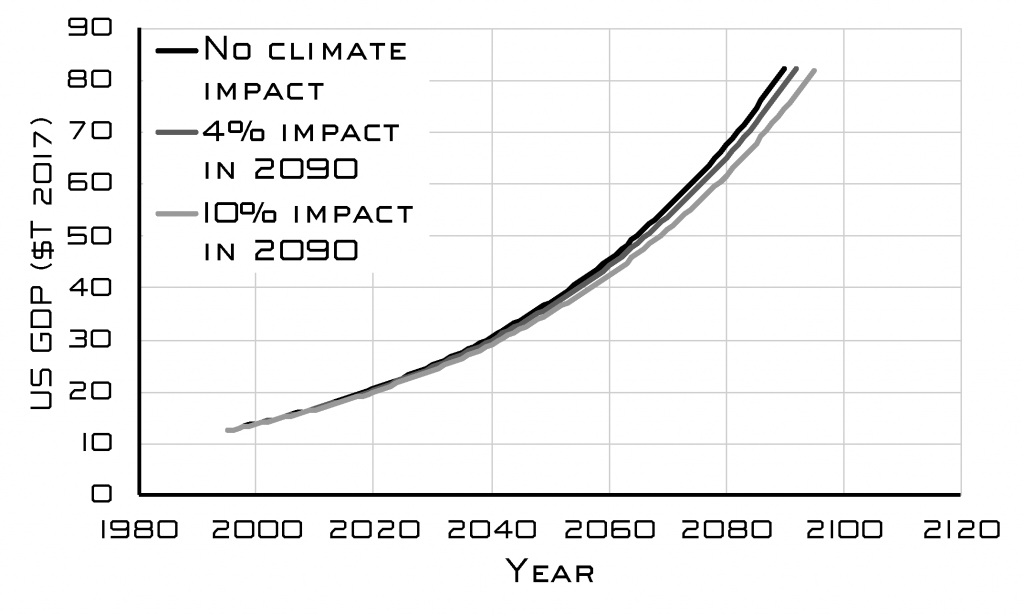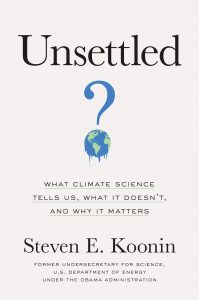In his book Unsettled: What Climate Science Tells Us, What It Doesn’t, and Why It Matters, Steven Koonin explores misconceptions and shortcomings in the media’s presentation of climate science. The following excerpt takes a closer look at the projected economic impact of climate change.
In 2018, on the day after Thanksgiving (Black Friday), the second volume of the Fourth National Climate Assessment (NCA2018) was released. It deals with the projected impacts of human-induced climate change, and it immediately generated the now familiar headlines warning of impending economic disaster, among them:
- “Climate change will wallop the US economy” (NBC News)
- “Climate report warns of grim economic consequences” (Fox News)
- “Climate change could cost US billions” (Financial Times)
- “US climate report warns of damaged environment and shrinking economy” (New York Times)
Indeed, Key Message 2 of the report’s Chapter 29 reads:
In the absence of more significant global mitigation efforts, climate change is projected to impose substantial damages on the US economy, human health, and the environment. Under scenarios with high emissions and limited or no adaptation, annual losses in some sectors are estimated to grow to hundreds of billions of dollars by the end of the century.
Both the Key Message and the heated headlines greatly dismayed me—they’re clearly intended to be frightening. Yet I had studied the issue and knew that the projected net economic impacts were minimal. Let me explain.
I first looked into the economic impacts of climate change the year before, in 2017, when one of the world’s largest investment organizations requested my advice on climate science. Since they’d asked that I cover economic impacts, I had carefully read what the UN’s Fifth Assessment Report (AR5) had to say on the matter.
Projections of the economic impacts of a changing climate are highly uncertain. Of course, we already know there are great uncertainties in how the climate will change because of inadequate climate models and uncertainty in future emissions. And climate uncertainties are larger at the regional level than they are at the global level. For example, for the first five or six years of the recent California drought, many climate scientists said that human influences on the climate increased the risk of drought. Yet it took only about a year after the drought broke dramatically in 2016 for papers to appear claiming that a warming world would also mean a wetter California. Perhaps this is just the process of scientific understanding being refined. Less charitably, I get the distinct sense that the science is unsettled enough that any unusual weather can be “attributed” to human influences.
In addition, climate is only one of many factors influencing economic development and well-being. Economic policies, trade, technology, and governance are also important, and these are different in different countries and can change in unpredictable ways. Economic measures are highly regional, and their future uncertainties are compounded by the uncertainty of regional climate predictions. It is particularly difficult to predict how, and how much, a rising temperature would damage a society economically in the face of so many unknowns—among them the role that might be played by adaptation measures like the raising of sea walls or shifts in what crops are cultivated that minimize, or sometimes even exploit, the impact of climate changes.
Despite those challenges, the AR5’s Working Group II—whose part of the assessment is devoted to the ecological and societal impacts of the changes in climate outlined by Working Group I—does say something about how world economic activity would be affected by a warming globe. Figure 9.4 plots some twenty published estimates showing that the (by now familiar) projected global temperature rise of up to 3°C by 2100 would negatively impact the global economy by—wait for it—3 percent or less.

For my talk to the investors, I provided some important context that was missing from the UN report. An impact of 3 percent in 2100—some eighty years from now—translates to a decrease in the annual growth rate by an average of 3 percent divided by 80, or about 0.04 percent per year. The IPCC scenarios assume an average global annual growth rate of about 2 percent through 2100; the climate impact would then be a 0.04 percent decrease in that 2 percent growth rate, for a resulting growth rate of 1.96 percent. In other words, the UN report says that the economic impact of human-induced climate change is negligible, at most a bump in the road. In fact, the first point in the Executive Summary to its Chapter 10 is:
For most economic sectors, the impact of climate change will be small relative to the impacts of other drivers (medium evidence, high agreement). Changes in population, age, income, technology, relative prices, lifestyle, regulation, governance, and many other aspects of socioeconomic development will have an impact on the supply and demand of economic goods and services that is large relative to the impact of climate change.
A 2018 article written by one of the IPCC’s coordinating lead authors reviewed a further four years of published papers and came to a similar conclusion:
. . . the total economic impacts of climate change are negative, but modest on average, and that the severe impacts on less developed countries are caused primarily by poverty.
The consensus on the minimal overall economic impact of rising temperatures is well known to experts, though it’s an inconvenient one for those wishing to sound the alarm on climate. I was dumbfounded when I asked a prominent environmental policymaker about the UN assessment and the response was: “Yes, it’s unfortunate that the impact numbers are so small.”
At any rate, this background left me primed to weigh in on the breathless coverage that accompanied the release of Volume II of NCA2018. The last figure in that report’s last chapter (reproduced in Figure 9.5) is based on a 2017 paper published in Science magazine. It shows that projected direct damages to the US economy at the end of the century grow with increasing global average temperature (shown as the anomaly relative to the 1980–2010 average). As in the IPCC projection for the world economy, the impacts on the US are small: a very large warming of 5°C (9°F) at the end of the century would diminish the US economy by 4 percent. (It’s worth noting that this 5°C warming is relative to today’s temperatures, which are up 1°C from preindustrial values, making this equal to 6°C of warming by the Paris Agreement accounting, which has set 1.5°C as a goal.)

Like the UN report, NCA2018 fails to put this in context, but I can do so quite simply: The US economy has grown at an average annual rate of 3.2 percent since 1930 (it’s almost twenty times larger now that it was ninety years ago). Under the conservative assumption that annual economic growth will average 2 percent for the next seventy years, the US economy will be four times larger in 2090 than it is today. The purported climate impact of 4 percent in 2090 then corresponds to two years of growth. In other words, an additional warming of 5°C (9°F) by 2090 would delay the growth of the US economy to that time—seventy years from now—by only two years.
Figure 9.6 makes that point graphically. Notice the bunching of the three curves. One curve shows that, absent any climate impact, a US economy growing at the assumed 2 percent average annual rate would see the GDP rise from today’s $20 trillion to $80 trillion in 2090. Another assumes a warming of 5°C, which according to NCA2018 would produce a slightly delayed growth curve, 4 percent less in 2090 than it would be otherwise. Finally, there’s the curve for a warming of 7.2°C (13°F)—a level of warming well beyond what’s projected under even the most extreme IPCC scenario. According to NCA2018, this would result in a 10 percent hit between now and 2090, which still amounts to only a five-year delay in growth seventy years from now.

Within a few hours of the NCA2018’s release on Black Friday, I had drafted a short Op-Ed saying more or less what I have said here, which the Wall Street Journal published online on Monday. The next day, a prominent US energy economist sent an email thanking me for making the point—alas, that person could never express that thanks publicly. The next week, one of the authors of the original 2017 research paper from which the estimates used in the assessment report were drawn expressed dismay at the way their results were portrayed in the media.
The climate science establishment, most notably the authors of NCA2018, reacted to my Op-Ed with silence. They did nothing to address the media’s catastrophizing. Perhaps they were embarrassed by their own doom mongering. Or perhaps, like the policymaker I mentioned earlier who wished the impact numbers had been greater, it was precisely the coverage they’d been hoping for.
As you’ve no doubt noticed yourself, the notion of climate-related economic disaster remains alive and well in the media and political dialogue. Economics has been called the “dismal science,” and I once joked to a prominent economist that the compounding of climate and economic projections is a “doubly dismal” enterprise. It is reasonable to expect that factors related to climate changes—including shifts in agricultural conditions or variations in storm patterns—will have different economic impacts (and benefits) on certain populations and economic sectors. Yet contrary to popular belief, even the official assessment reports indicate that significant human-induced climate change would have negligible net economic impact on either the world or the US economies by the end of this century.







